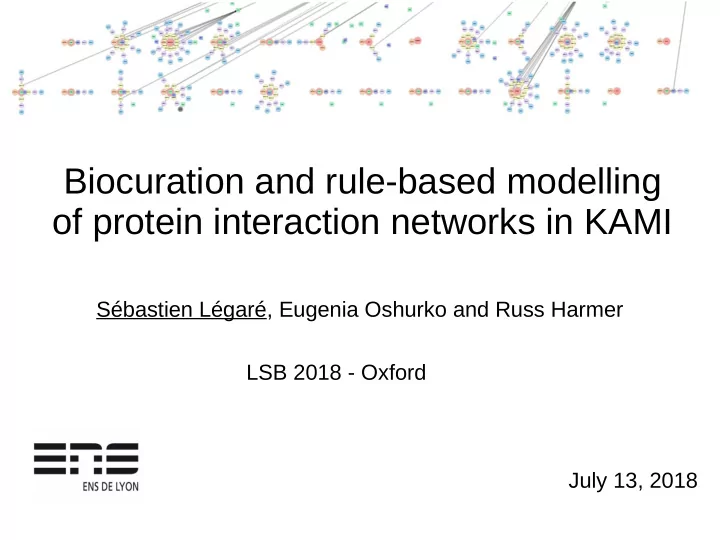

Biocuration and rule-based modelling of protein interaction networks in KAMI Sébastien Légaré, Eugenia Oshurko and Russ Harmer LSB 2018 - Oxford July 13, 2018
Introduction What does K A M I stand for? K nowledge A ggregator and M odel I nstantiator What is special about KAMI ? - Rule-based strategy - Incremental aggregation of large models - Allows a posteriori understanding of models 1/21
Outline KAMI 1) KAMIStudio (KAMI GUI) 2) Knowledge representation ( Nugget / ActionGraph ) 3) Building a model Kappa 4) Rule-based executable model 5) Pathway discovery ( Causality analysis ) 6) The pYnet model 2/21
Knowledge representation Split in two layers, the nuggets and action graph - Unambiguously specify interactions - Limited set of symbols Can read a model using KAMIStudio Every nugget is independent - Facilitates incremental aggregation 3/21
Building a KAMI model KAMI interaction (programmatic) KAMI nugget (graph representation) Binding ( RegionActor( gene=Gene(uniprot_ac="P00519", hgnc_symbol=" ABL1 "), region=Region(name=" SH2 ", interproid="IPR000980") ), SiteActor( gene=Gene(uniprot_ac="P11274", hgnc_symbol=" BCR "), site=Site(name="pY246", residues=[Residue(aa=" Y ", loc= 246 , state=State(" phosphorylation ", True ))]) ), rate=0.001, desc="ABL1 binds BCR-Y246" ) 4/21
How does it work? KAMI graph hierarchy → N : Nugget A : Action Graph Arrow : Typing 5/21
Typing 6/21
Typing 6/21
Typing 6/21
Typing 6/21
Semantic nuggets 7/21
Knowledge aggregation 8/21
Knowledge aggregation 8/21
Knowledge aggregation (continued) 9/21
Knowledge aggregation (continued) 9/21
Biocuration with KAMI Allows users to easily add new data - Detects elements already present in action graph - Semantic checks - Completes interaction if more detailed - Ignores new data if it already exists 10/21
Kappa rule-based model KAMI nugget Kappa rule ABL1(SH2[./1]), BCR(pY246[./1] Y246_phos{True}) 11/21
1 nugget ≈ 1 rule (info from AG) IFGR1( pY1281[./1] Y1281_phos{True} ), ABL1(SH2[./1]) IFGR1( pY1280[./1] Y1280_phos{True} ), ITK(SH2[./1]) 12/21
1 nugget ≈ 1 rule (info from AG) Nuggets Action Graph IFGR1( pY1281[./1] Y1281_phos{True} ), ABL1(SH2[./1]) IFGR1( pY1280[./1] Y1280_phos{True} ), ITK(SH2[./1]) 12/21
1 nugget ≈ 1 rule (info from AG) Nuggets Action Graph IFGR1( pY1280-1[./1] Y1281_phos{True} ), ABL1(SH2[./1]) = IFGR1( pY1280-1[./1] Y1280_phos{True} ), ITK(SH2[./1]) 12/21
Simulations with KaSim SHC1 ● Rule-based BCR ● Deals with combinatorial ABL1 SYK complexity FES ● Quantitative ● Stochastic ● No spatial dimension ● Analysis system dynamics 13/21
Causality Analysis (KaStor) Expected pathway EGFR dimerizes and recruits GRB2 Recruited GRB2 14/21
Causality Analysis (KaStor) Discovered pathway ZAP70 involved in GRB2 recruitment Recruited GRB2 15/21
The pYnet model Cell signaling - Tyrosine phosphorylation - SH2 domain bindings 900 interactions extracted from - PhosphoSite - Phospho.ELM - NCI Pathway Interaction Database Well suited to showcase rule-based modelling - Combinatorial complexity - Large - Scaffolding 16/21
Important combinatorial compl. Processive phosphorylation 17/21
Summary KAMI allows - Representation of individual interactions - Aggregation into an interaction network KAMI works with Kappa to - Produce dynamic simulations - Discover pathway using causality analysis 18/21
Summary Fundamentally different approach to modelling - No need to know exactly where new data fits - Can just “smash” interactions together - No need to explicitly build the pathways (bias) - Can discover the pathways through analysis 19/21
Using KAMI and Kappa In development KAMI: github.com/Kappa-Dev/KAMI KAMIStudio: github.com/Kappa-Dev/KAMIStudio Graph rewriting ReGraph: github.com/Kappa-Dev/ReGraph Kappa KaSim: github.com/Kappa-Dev/KaSim.git Web Site: kappalanguage.org 20/21
Thanks Jérôme Feret Walter Fontana Russ Harmer Vincent Danos Pierre Boutillier Eugenia Oshurko Yves-Stan Hector Medina Le Cornec Ioana Cristescu Jean Krivine 21/21
Recommend
More recommend